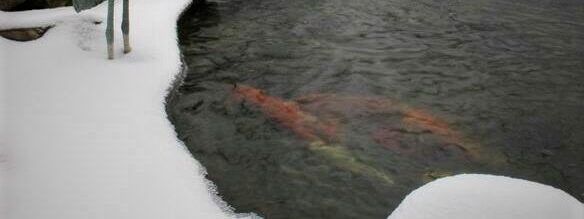There are several issues to keep in mind when caring for pond fish as the days grow cooler. First and foremost, your fish need a pond depth of at least 18 to 24 inches or more in order to overwinter successfully. If your pond is shallower, you’ll need to find new quarters for them through the winter months. Regardless of pond depth, it’s best to bring sensitive fish like exotic goldfish indoors during winter. Once temperatures drop to 50F, refrain from feeding the fish. They need to get ready for hibernation and you’ll want to avoid any metabolic complications.
If you live in an area where it gets chilly enough for the pond to freeze over, you need to make sure the pond water stays oxygenated for your finned friends. Some pond owners opt to keep their waterfalls running throughout the winter, which will help aerate the water and ensure a successful hibernation for your fish.

If you decide to shut down your waterfalls for the winter, first unplug the waterfall pump, remove it from the pond or skimmer, and then store it in a frost-free location. Place a pond aerator or a submersible pump on the second shelf of your pond so it bubbles right at the surface of the water. If winter temperatures aren’t drastically frigid, the bubbling of the pump should be enough to keep an open hole in the ice. Keeping a hole in the ice allows potentially harmful gasses to escape, helping to ensure the health of your fish.
In exceptionally cold weather when the entire pond is liable to freeze over, you’ll want to add a floating de-icer to the pond. Controlled by a thermostat, the unit only runs when the water temperature is at or below freezing, heating only the immediately surrounding water to just above that, and then shutting off again. In northern areas of the country, the best solution is to implement a combination of a small pump and de-icer.
If you opt to keep your waterfall running throughout winter, you’ll enjoy amazing ice sculptures. Since the waterfalls help to aerate the water, a small pump for oxygenation won’t be necessary, although you can use an aerator or de-icer to help keep a hole in the ice during frigid blasts of weather. Don’t be surprised if some of the pond water evaporates during winter if you leave the falls running. Although water loss is considerably less in the winter than it is in summer, you may find yourself needing to add water at some point. Also, check to make sure an ice dam isn’t causing water to trickle out of the pond.

Enjoy the Winter Solstice
Snow and ice formations sculpted from a frosty waterfall are some of the most spectacular winter sights you’ll enjoy in your garden. Tiny stalactites and stalagmites will delight your senses and each fresh blanket of snow will provide enchanting wonderment. Take time to enjoy the peace of winter solstice and the quiet splendor of your snowy garden. Winter is the perfect time to rest from summer’s heyday of activities as you anticipate the emergence of pond life when warmer days roll around.

